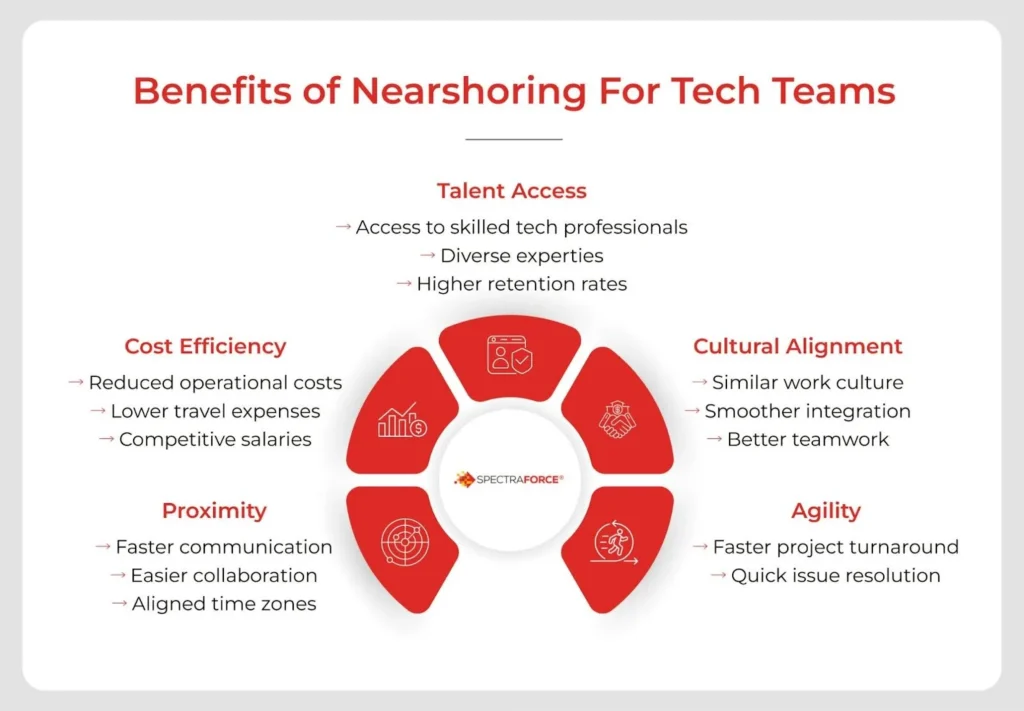Roadmaps don’t slip because teams forgot how to build. They slip because the right people aren’t available when decisions need to be made, or they’re 8–10 hours away.
The impact is familiar: overnight reviews, slow incident response, and product changes that take an extra sprint. Nearshoring for tech addresses the timing problem by placing skilled engineers in nearby time zones, allowing for live collaboration and predictable delivery without exceeding the budget.
Overlap is the lever. When teams share working hours, standups, reviews, pairing, and on-call happen on the same day. “Blocked until tomorrow” becomes “In Motion, On Schedule” before lunch. The payoff is steady throughput with shorter cycles, faster issue resolution, and planning that actually works because decision‑makers are online together.
What is nearshore staffing?
Nearshore IT staffing is the practice of adding employees from nearby countries that share working hours with the core team. The goal is straightforward: scale quickly while maintaining real-time collaboration.
In practice, it shows up in two straightforward ways. Sometimes companies plug in individual engineers or a small senior pod directly into their existing tools and rituals, so they behave like an extension of the in-house team.
Other times, they bring in a cross-functional squad, say backend, QA, and SRE, with clear capacity, sprint goals, and service levels, so the unit is accountable for outcomes alongside the tasks.
Imagine a U.S. SaaS company that needs to accelerate a billing rewrite after two sprints of slipped reviews. They add a senior-heavy pod from Latin America that mirrors their stack and joins daily standups with four hours of overlap. Within a few weeks, pull requests start being reviewed the same day, flaky tests are stabilized, and the feature ships behind a flag on schedule. Same tools, same rituals, just the right people working at the same time.
Without that overlap, every review and fix would roll to the next day, dragging cycle time and stretching the rewrite by weeks. Hiring the same senior capacity in the U.S. would be slower to staff and significantly more expensive, turning a delivery problem into both a timeline and budget problem.
What nearshoring solves (and why it changes delivery)

The core difference that makes nearshoring better than farshoring is tempo. Work happens, just not when decisions do. Nearshoring for tech restores real‑time cadence by aligning teams in compatible time zones, so collaboration fits the workday instead of the next day.
With a 4–6 hour overlap, feedback is received the same day, fixes don’t wait overnight, and incident response aligns with customer hours.
Communication also becomes clearer with shared work norms, strong English, and easy travel, which reduces the micro-misunderstandings that quietly slow teams down.
Crucially, the talent pools are there: experienced nearshore engineers in backend, data, QA, SRE, and platform who plug in fast and work the same hours.
What shifts immediately:
- Time zone alignment: same‑day standups, reviews, pairing, and on‑call.
- Clearer communication: fewer misreads, easier escalation, practical on‑sites.
- Ready talent pools: senior engineers across core disciplines, accustomed to enterprise and startup pace.
- Faster start: nearshore IT staffing pipelines reduce search and onboarding drag.
Overlap enables live planning and review cycles that shrink total time. Mirrored CI/CD, testing, and observability shorten onboarding, so contributions start quickly.
Quality stabilizes as continuous reviews reduce rework. Management overhead drops because there are fewer windows to bridge and fewer handoff artifacts to maintain. Proximity lowers risk: audits, calibration, and trust-building are simpler when travel is practical. Cost helps; throughput wins.
And here’s where nearshoring pulls ahead:
- Rapid iteration: weekly product pivots need same‑day decisions, not next‑day replies.
- Cross-functional tradeoffs: product, design, and engineering resolve ambiguity in real-time.
- Reliability and support: SRE/platform aligned to customer hours, cut MTTR without weekend heroics.
- Compliance-heavy work: shared calendars and feasible on-site reviews streamline approvals.
Also read: 7 Warning Signs You Need Outsourced Technical Support Before It Hurts Productivity
Choosing a nearshore staffing partner
A nearshore staffing partner sources, vets, and integrates employees who work in overlapping time zones with the core team. They design how those people plug into workflows, protect delivery standards, and keep the engine running when priorities shift.
The right partner turns good engineers into a reliable capability; the wrong one turns hiring into chaos.
Picking a nearshoring partner shouldn’t feel like rolling the dice. Treat it like hiring a senior leader. You’re trusting them with delivery, not just headcount. Here’s what they should offer:
- Flexible delivery
Can they start small with augmentation and, if it works, scale into managed squads? Can they also scale down when priorities change? - Real vetting, not checklists
Look for system design interviews, hands-on coding, English proficiency, and SDLC fluency, with a clear rubric they’re willing to share. - Time-to-fill, you can verify
Ask for actual, recent fill times by role because bench transparency beats optimistic estimates. - Overlap guaranteed in writing
The promise is live collaboration. Ensure the contract clearly outlines working-hour overlap and escalation paths.\ - Security, you can audit
Expect documented policies (SOC/ISO alignment), device management, SSO/zero trust, data handling standards, and clean offboarding. If they can’t show it, assume it isn’t there. - Retention that keeps teams steady
What career paths, feedback loops, and engagement practices exist? High churn turns strong talent into unreliable capacity. - Evidence of how they run delivery
Request to review sprint artifacts, runbooks, incident retrospectives, and defect triage workflows. Clear SLAs and a concrete “definition of done” are non-negotiable.
One last filter: an agency fills roles. A partner protects outcomes. Choose the one that will stand next to the roadmap when stakes are high.
How to implement nearshoring in 90 days (a step‑by‑step rollout)
Wondering how to stand up a nearshore team and make it productive within three months? The goal: integrate nearshore engineers into existing workflows, prove impact with a small, senior nucleus, then scale into pods or managed squads based on measurable results.
Weeks 0–2: Set foundations and align ways of working
- Define team shape (roles, seniority, coverage), access, and a clear definition of “Done”.
- Mirror your CI/CD, testing, and observability so nearshore engineers plug into the same pipelines and dashboards.
- Establish ceremonies (planning, stand-ups, and reviews) with crisp agendas and named owners.
- Document overlap windows and escalation paths to protect real-time collaboration.
Weeks 3–6: Ship a thin slice and measure what matters
- Start with a senior nucleus and deliver an end-to-end slice (small, valuable, testable).
- Pair on critical paths and keep scope tight.
- Track a minimal set of truth-telling metrics: cycle time, review latency, escaped defects, and on-call noise.
- Use these signals to fine-tune roles, rituals, and handoffs.
Weeks 7–12: Scale with evidence and harden operations
- Add QA, data, or SRE only where metrics justify it.
- Introduce SLOs and error budgets; run incident retros that produce concrete fixes.
- Harden runbooks, clarify ownership, and audit access.
- If the pod is consistently hitting goals, evolve it into a managed squad with capacity commitments and SLAs to lock in predictability.
By Day 90, aim for this operating state
- Contributions in weeks, not months, with same-day reviews as standard.
- Lower cycle time and MTTR aligned to customer hours.
- Clear working agreements, audited access, and clean offboarding in place.
- A proven path to scale up or down without breaking cadence or quality.
This is the point at which nearshoring becomes a steady, measurable, and ready-to-expand part of the operating model.
Conclusion: Turn overlap into an advantage
Nearshoring is an execution upgrade. When teams share working hours, decisions land faster, releases steady out, and leaders manage less drag. That advantage compounds only when it’s wired into how the team works.
Turn intent into motion with a tight, low-risk path:
- Run a six-week pilot with a senior nucleus focused on one valuable slice. Hold the line on four metrics: cycle time, review latency, deployment frequency, and incident resolution time. Let the numbers call the shots.
- If the signal is strong, lock in the model. Write overlap into contracts, formalize SLAs, and evolve from augmentation to a managed squad where reliability matters most.
- If the signal is weak, don’t abandon the approach; adjust. Tune the team shape, refine handoffs, or tighten ownership. Iterate quickly and re-measure.
One more safeguard that separates durable models from fragile ones: resilience. Confirm device management, access controls, data boundaries, and clean offboarding.
This is where a real nearshore staffing partner stands up. The upside is straightforward: talent where supply exists, working when the team works. The result is a roadmap that moves on purpose instead of in bursts.
Prefer a pilot over promises? Explore SPECTRAFORCE nearshoring staffing solutions.
FAQs
Nearshoring in the tech industry involves placing engineering teams in nearby regions with overlapping work hours, enabling real-time collaboration.
Nearshoring helps address tech talent shortages by providing access to larger nearby talent pools and reducing time-to-fill with pre-vetted candidates, while maintaining live collaboration.
Time zone alignment is crucial in nearshoring because it enables same-day feedback, reduces rework, prevents context loss, and maintains high momentum.
Nearshoring is cost-effective for tech companies mainly through productivity gains and lower management overhead; hourly rates help, but improved throughput drives ROI.
You can choose the right nearshoring partner by looking for:
1. Rigorous vetting (design + coding + communication) with a clear rubric
2. Overlap guaranteed in writing (specific hours and escalation paths)
3. Strong security (policies, device management, SSO/zero trust, clean offboarding)
4. Proven retention (how they keep teams stable over time)
5. Real delivery evidence (sprint artifacts, runbooks, incident retros, SLAs)



